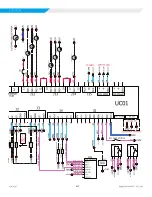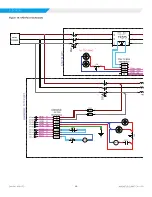
9
IOM 1297
WWW.DAIKINAPPLIED.COM
INSTALLATION
Vessel Drains at Startup
The unit is drained of water at the factory. Units are shipped with
the drain plug in the top water box drain hole and no plug in the
bottom drain hole. Drain plugs for each vessel head are shipped
separately in the control box. Be sure to install the bottom drain
plugs prior to filling the vessel with fluid.
Figure 5: Drain Plug Installation
Water Quality Guidelines
The water quality provided by the owner/occupant/operator/user
to a chiller system should minimize corrosion, scale buildup,
erosion, and biological growth for optimum efficiency of HVAC
equipment without creating a hazard to operating personnel or
the environment. Strainers must be used to protect the chiller
systems from water-borne debris. Daikin Applied will not be
responsible for any water-borne debris damage or water side
damage to the chiller heat exchangers due to improperly treated
water.
Water systems should be cleaned and flushed prior to chiller
installation. Water testing and treatment should be verified during
initial chiller installation/commissioning and maintained on a
continuous basis by water treatment professionals (see Limited
Product Warranty).
WARNING
The improper use of detergents, chemicals, and additives in the
chiller system water may adversely affect chiller performance
and potentially lead to repair costs not covered by warranty. Any
decision to use these products is at the discretion of the owner/
occupant/operator/user and as such they assume full liability/
responsibility for any damage that may occur due to their use.
Pressure Relief Devices
As a safety precaution and to meet code requirements, each
chiller is equipped with rupture disks located on the condenser
and evaporator for the purpose of relieving excessive refrigerant
pressure (caused by equipment malfunction, fire, etc.) to the
atmosphere.
Table 2: WMT Relief Valve Data
Evaporator
Condenser
Location
Top
Top
Pressure
Setting
44 psig
44 psig
Discharge
Capacity
243 lb/min. air
243 lb/min. air
Qty
1
1
Connection 2 inch B16.5 Flange
Most codes require that pressure relief devices be vented to the
outside of a building. Relief piping connections to the relief valves
must have flexible connectors.
Remove plastic shipping plugs (if installed) from the inside of the
valves prior to making pipe connections. Whenever vent piping
is installed, the lines must be in accordance with local code
requirements. Where local codes do not apply, the latest issue
of ANSI/ASHRAE Standard 15 code recommendations must be
followed.
Field Insulation
If the optional factory installation of thermal insulation is not
ordered, insulation should be field installed to reduce heat loss
and prevent condensation from forming. Insulation should cover:
•
The evaporator barrel, tube sheet, and waterboxes
•
The suction line from the top of the evaporator to the
compressor inlet flange
•
The compressor support brackets welded to the evaporator
•
The liquid line from the expansion valve to the evaporator
inlet, including the expansion valve
•
Evaporator distributor pipes
•
Economizer barrel and end-sheet
•
Compressor interstage pipe
Approximate total square footage of insulation surface required
for individual packaged chillers is tabulated by evaporator code
and can be found in
Table 9
.
Table 3: Insulation Area Required for WMT Models
Evaporator Code
Insulation Area
ft . ^2
Insulation Area
m^2
E3612
406
37 .7
E4212
449
41 .7
E3615
460
42 .7










































